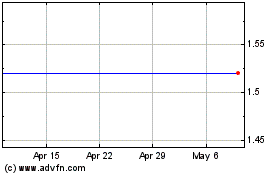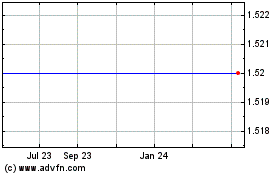Neuralstem Announces NSI-189 Shows Enhancement of Long-Term Potentiation In Vitro
June 21 2016 - 8:15AM

Neuralstem, Inc. (Nasdaq:CUR), a biopharmaceutical company focused
on the development of central nervous system therapies based on its
neural stem cell technology, announced that new in vitro data on
NSI-189 provide insight into the neurogenic drug’s mode of
action. In a study entitled, “NSI-189, a neurogenic compound
enhances short-term and long-term potentiation in C57Bl/6 mice and
reverses LTP impairment in a mouse model of Angelman syndrome,”
researchers led by Michel Baudry, PhD, Dean of the Graduate College
of Biomedical College, at Western University of Health Sciences, in
Pomona, CA, found that 1-3.5 hours of pre-treatment of C57Bl/6
mouse hippocampal slices with NSI-189 produced a time- and
concentration-dependent enhancement of both short-term potentiation
(STP) and long-term potentiation (LTP) magnitude. STP, and
more specifically LTP, refer to the strengthening of communication
between neurons, a key component of synaptic plasticity, which play
critical roles in memory formation and cognition.
Additionally, 3.5 hours of pre-treatment with
NSI-189 restored LTP in hippocampal slices from a mouse model of
Angelman syndrome (Ube3am-/p+ mice), which exhibits a deficit in
LTP and learning and memory. Angelman syndrome is a genetic
disease that occurs in 1 in 15,000 live births, which leads to
mental disabilities and other neurological problems.
“This is an intriguing and novel effect,” said
Dr. Baudry, the study lead researcher. “NSI-189 had no effect
on synaptic transmission and no effect on NMDA receptor properties,
but increased LTP magnitude in a time-dependent manner within hours
of incubation in hippocampal slices. Plus, a short-term
treatment with the drug restored LTP in hippocampal slices from
genetically defective Angelman mice, suggesting NSI-189 may enhance
cognition under many different conditions.”
“NSI-189 is a neurogenic compound in vitro and
in vivo, which takes days-to-weeks to produce biological effects,”
said Karl Johe, PhD, Neuralstem’s Chief Scientific Officer and
discoverer of NSI-189. “Now, with the results in brain slices, we
see that NSI-189 can directly and powerfully enhance brain
functions in a few hours. This means that NSI-189 activates a
specific molecular pathway within hours and its effect is
cumulative over exposure time. I am confident that with this brain
slice assay, along with our proprietary human hippocampal neural
stem cell lines, we will be able to uncover the underlying
molecular pathway.”
About Neuralstem
Neuralstem's patented technology enables the commercial-scale
production of multiple types of central nervous system stem cells,
which are being developed as potential therapies for multiple
central nervous system diseases and conditions.
Neuralstem's ability to generate neural stem cell lines from
human hippocampus, which were used for systematic chemical
screening for neurogenesis effect, has led to the discovery and
patenting of molecules that Neuralstem believes may stimulate the
brain's capacity to generate new neurons, potentially reversing
pathophysiologies associated with certain central nervous system
(CNS) conditions.
The company has completed Phase 1a and 1b trials evaluating
NSI-189, its first neurogenic small molecule product candidate, for
the treatment of major depressive disorder or MDD, and is currently
conducting a Phase 2 efficacy study for MDD.
Neuralstem's first stem cell product candidate, NSI-566, a
spinal cord-derived neural stem cell line, is under development for
treatment of amyotrophic lateral sclerosis (ALS). Neuralstem
has completed two clinical studies, in a total of thirty patients,
which met primary safety endpoints. In addition to ALS,
NSI-566 is also in a Phase 1 study to treat paralysis due to
chronic spinal cord injury, as well as in a Phase 1 study to treat
paralysis from ischemic stroke.
Cautionary Statement Regarding Forward Looking
Information:
This news release contains "forward-looking
statements" made pursuant to the "safe harbor" provisions of the
Private Securities Litigation Reform Act of 1995. Such
forward-looking statements relate to future, not past, events and
may often be identified by words such as "expect," "anticipate,"
"intend," "plan," "believe," "seek" or "will." Forward-looking
statements by their nature address matters that are, to different
degrees, uncertain. Specific risks and uncertainties that could
cause our actual results to differ materially from those expressed
in our forward-looking statements include risks inherent in the
development and commercialization of potential products,
uncertainty of clinical trial results or regulatory approvals or
clearances, need for future capital, dependence upon collaborators
and maintenance of our intellectual property rights. Actual results
may differ materially from the results anticipated in these
forward-looking statements. Additional information on potential
factors that could affect our results and other risks and
uncertainties are detailed from time to time in Neuralstem's
periodic reports, including the Annual Report on Form 10-K for the
year ended December 31, 2015, and Form 10-Q for the three months
ended March 31, 2016, filed with the Securities and Exchange
Commission (SEC), and in other reports filed with the SEC.
Contact:
Neuralstem – Investor Relations:
Danielle Spangler
301.366.1481
Planet Communications - Media Relations:
Deanne Eagle
917.837.5866
Neuralstem (NASDAQ:CUR)
Historical Stock Chart
From Mar 2024 to Apr 2024

Neuralstem (NASDAQ:CUR)
Historical Stock Chart
From Apr 2023 to Apr 2024
